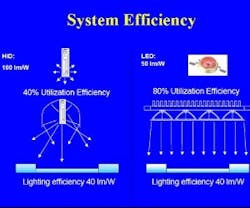Due to lighting’s impact on human productivity, you cannot do a good lighting retrofit without understanding lighting quality. Energy costs are only about 1% of the size of labor costs, so it is important to have that 99% working at full productivity!
Although a bad lighting retrofit is instantly apparent, three concepts of lighting quality can lead you to a successful project. But first be sure you understand the occupants’ current needs (which may have changed over time) and match the light levels to their tasks. Proper targets for lighting level can be found in the lighting standards established by the Illuminating Engineering Society (IES). Similar to the intent of most HVAC standards, the IES goal is to make at least 80% of the occupants comfortable.
Lighting Quality Principle #1: Brightness and Glare
Effective lighting has a lot to do with contrast and glare-free illumination. This sounds like an obvious and easy objective, yet with many lighting retrofits that transition from incandescent or fluorescent to LEDs, the new lamps may not fit properly within an existing fixture, and thus the fixture’s optics can be altered. So before doing a major lighting retrofit, make sure to test new fixtures or new lamps in existing fixtures to ensure that you don’t introduce unwanted glare into the occupants’ space.
In recent years, LEDs have become increasingly popular due to their efficacy (lumens per watt) and ability to focus light out of a fixture more efficiently than traditional fluorescent and incandescent lamps. Figure 1 illustrates how lumens from different lamps escape a fixture. Increased delivery is a win from an energy standpoint, but we must remember that the increased brightness usually translates into more glare for the occupant.
The Coefficient of Utilization is a value (1-100 scale) that indicates how efficient the delivery of the light is from source to target. This is a function of the lamp/fixture as well as the reflectance of the walls and ceilings. Again, a balance between brightness and comfort is required.
Lighting Quality Principle #2: Color Temperature
Another key issue is ambiance. Healthcare facilities usually prefer white light because they want to project the image of a sterile and germ-free area. In contrast, banks, steakhouses and Starbucks stores may want a dimmer, warmer environment.
Color temperature refers to the color of the light source. This factor is measured by correlated color temperature (CCT), which represents the wavelength of light emanating from a specific temperature. The cooler or more bluish the lamp appears, the higher the CCT.
Below are a few common CCTs for lighting. Figure 2 illustrates a broader range with the associated colors of different CCTs.
4100K = Cool White (traditional fluorescent)
3500K = Warm White (warm white fluorescent)
2700K = Incandescent
Lighting Quality Principle #3: Color Rendering Index
Color Rendering Index (CRI) measures how well occupants can distinguish colors under different light sources. CRIs range from 1 to 100. Because this scale was developed during the age of the incandescent lamp, the incandescent lamp was given a CRI of 100. However, most people find that colors are more vibrant outside on a clear day rather than under incandescent light.
Most fluorescent lamps have a CRI of 70-80, and some technologies have excellent CRIs in the 90s. In contrast, traditional yellow street lights (high pressure sodium lamps) have CRIs around 65. CRIs below 60 mean that colors will appear unnatural, faded or even gray.
One of the major failures in the lighting industry today is not putting the CRI on the packaging label, even though CCT is on most labels. I have purchased many LED lamps at home improvement stores and most labels do not indicate the lamp’s CRI. This can be frustrating when you want good color rendition, but can’t know what you are buying until you install it.
From my experience relighting my wife’s bathroom vanity lights, I know that only high CRI LEDs would do the job – or I would have an unhappy occupant.
---------------------------------------------------------
Aging Lighting – Replace or Retrofit?
Dig down to your project’s benefits.
8 Simple Strategies to Maximize Energy Savings
Take charge of your utility bill.
How FM and IT Can Partner for Energy Savings
Target energy-hogging technology with efficiency initiatives.
